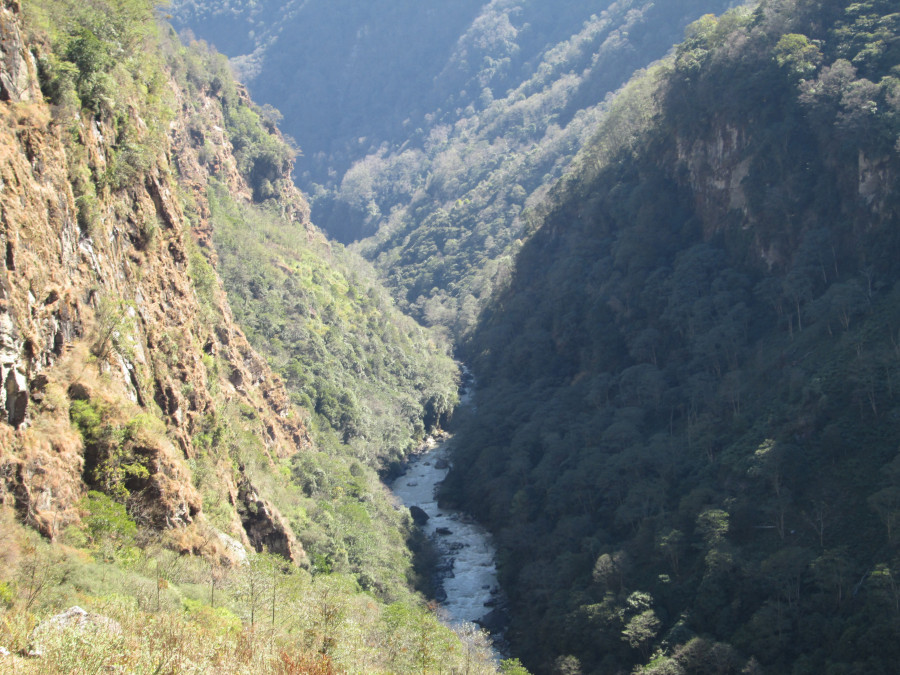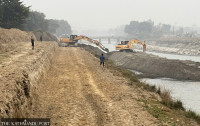National
After 27 years, World Bank returns to Arun River
The lender will lead international financiers to invest in 1061 MW Upper Arun Hydropower Project. The bank had pulled out of Arun III in 1995.
Prithvi Man Shrestha
The World Bank has returned to the Arun River to help develop a new hydropower project 27 years after it shelved its plan to invest in the Arun III Hydropower Project on the same river.
The World Bank will be the lead international financial institution to finance the construction of the 1,061MW Upper Arun Hydroelectric Project in the upper reaches of the Arun river at Bhotekhola Rural Municipality of Sankhuwasbha district.
Nepal Electricity Authority (NEA), which will lead the equity investors in the project, said that the World Bank, the European Investment Bank and other international financial institutions would provide loans amounting to Rs97 billion to implement the project, whose total cost would be Rs214 billion ($1.75 billion).
According to an NEA statement, the project will be implemented under a 70:30 debt-to-equity ratio. This means, the project will be funded with Rs150 billion in loans including Rs97 billion from international financiers and Rs53 billion from domestic creditors.
The World Bank will lead the international financiers while the Hydroelectricity Investment and Development Company Limited (HIDCL) will lead the domestic financiers including Nepali banks and financial institutions, according to the NEA.
On Thursday, the NEA, the Upper Arun Hydroelectric Company (the project implementing agency) and the HIDCL signed an investment agreement to finance the project, according to the NEA.
It is for the first time the World Bank is funding an NEA-led hydropower project. In 2014, the global lending agency had approved $84.6 million to finance the Kabeli-A Hydroelectric Project developed by the private sector. In 2019, its private sector arm—the International Finance Corporation (IFC)—had led international creditors to invest $453 million for the development of the 216MW Upper Trishuli 1 Hydropower Project. A South Korean consortium is developing this project.
“The World Bank has been assisting us in constructing transmission line projects,” said Suresh Bhattarai, spokesperson for the NEA.
The bank had pulled out from the Arun III Hydropower Project in August 1995 after a big controversy over its huge construction costs among other things. Many experts point to the World Bank’s exit from the Arun III project as the reason behind the several years of prolonged electrical load-shedding in the country. Nepal had suffered prolonged power cuts since 2008 and it could officially end load-shedding fully only after ten years in May 2018.
On August 1, 1995, then World Bank President James Wolfensohn had cancelled the Arun III project “in agreement with the Government of Nepal” citing concerns regarding Nepal’s management capability to meet the demands and long list of actions which the project of this size and complexity would involve; difficulty in gaining popular support in implementing a number of measures including power tariff and prioritisation of public expenditure, and difficulty in mobilising additional $30-40 million cost overrun as a result of the delay in project implementation. SJVN Limited, India’a state-owned company is now developing the Arun III project.
“The World Bank along with other international lenders helping Nepal to develop large-sized hydropower projects is important for a country like ours which cannot generate such large-scale resources on its own,” said Bhattarai, NEA spokesperson.
Experts said borrowing from international donor agencies is cheaper compared to private creditors. “The donor agencies like the World Bank offer credits at concessional interest rates and the debt repayment period is also longer,” said former energy secretary Anup Upadhyay.
Sri Lanka is in huge debt as it accepted costly commercial loans with shorter repayment period. It is now defaulting on the loans from international creditors.
“When an institution like the World Bank is involved, other donor agencies also join hands in financing,” said Upadhyay.
International donor agencies have lately been more interested in Nepal’s power sector, which is also one of the most attractive investment sectors in the country.
Earlier, a consortium of donors led by the Asian Development Bank financed the 140MW Tanahu Hydropower Project. The ADB roped in the Japan International Cooperation Agency and the European Investment Bank to finance the project.
Chiranjeewee Chataut, director general at the Department of Electricity Development, said donor agencies now appear more interested in financing hydropower projects in Nepal compared to the past. “They are also seeing benefit for themselves from these investments while Nepal gets loans at concessional rates which helps reduce the project costs,” he added.
When it comes to Upper Arun, its detailed project report has already been prepared while the process for selecting consultants to design tender documents and construction supervision is under way, according to the NEA. It said the project construction is expected to begin in January 2025 and complete by the end of 2030. The project has already fixed the compensation to be paid for the 2,025 hectares of land that the project will occupy. The project will displace just 22 households, according to the NEA.
The state-owned power utility body said it would also develop the 30MW Ikhuwa Hydropower Project, which will be a subsidiary of the Upper Arun Project, the NEA said in the statement.




 10.12°C Kathmandu
10.12°C Kathmandu















